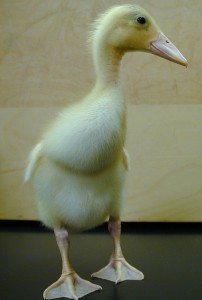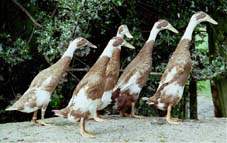|
Project Quack
|
|
Indian
Runner |
| Indian Runner Ducks, or Runners,
were developed in Scotland around 1900 from ancestors that were brought from
the East Indies. Indian Runner duck comes in many colors, among these are
white, fawn and white, penciled, buff, black, chocolate, Cumberland blue, and
grey (mallard color) This type of duck has a tall, narrow body and stands
almost vertical to the ground. These ducks are also referred to as "Bali
Penguins","Penquin Ducks", "Bottle Necks", and "Bowling Pin Ducks." The Indian
Runner's upright stature allows it to run quickly across the ground instead of
waddling. This characteristic makes this duck one of the most successful
forager of all domestic duck breeds. It is classified as a lightweight breed,
which grows as big as around 4 -4 1/2 lbs for the male and 3 1/2 - 4 lbs for
the female. Drakes are 26-32 inches long, and hens are 24-28 inches. |
 |
|
| |
 |
They are small ducks and very active. The Fawn and
White Indian Runner is the most popular color of the breed. The Fawn and White
Runner have a fawn colored breast and back and a fawn colored patch over the
eyes, which makes them look like they are wearing a mask. Their feet and legs
are a yellowish brown. Drakes have a slightly brighter color than the females.
|
| Indian Runners are good egg layers.
They lay extra large, white eggs that are out of proportion to their body.
However, they typically do not sit on their eggs. Indian Runner Ducks are
fairly good-natured, but can get somewhat nervous at times. This breed of duck
is very vocal. Their heads are long, straight, and flat compared with other
breeds, and their necks are long and slender. The breastbone of this duck is
not very prominent. Runners are often used for training sheep dogs because of
their speed and herding instinct (they are in the movie Babe.) Indian Runners
are a flightless breed of duck. |
|
| |
|
|
| |
|
|
| |
 Webspinner Table of Contents Webspinner Table of Contents |
|